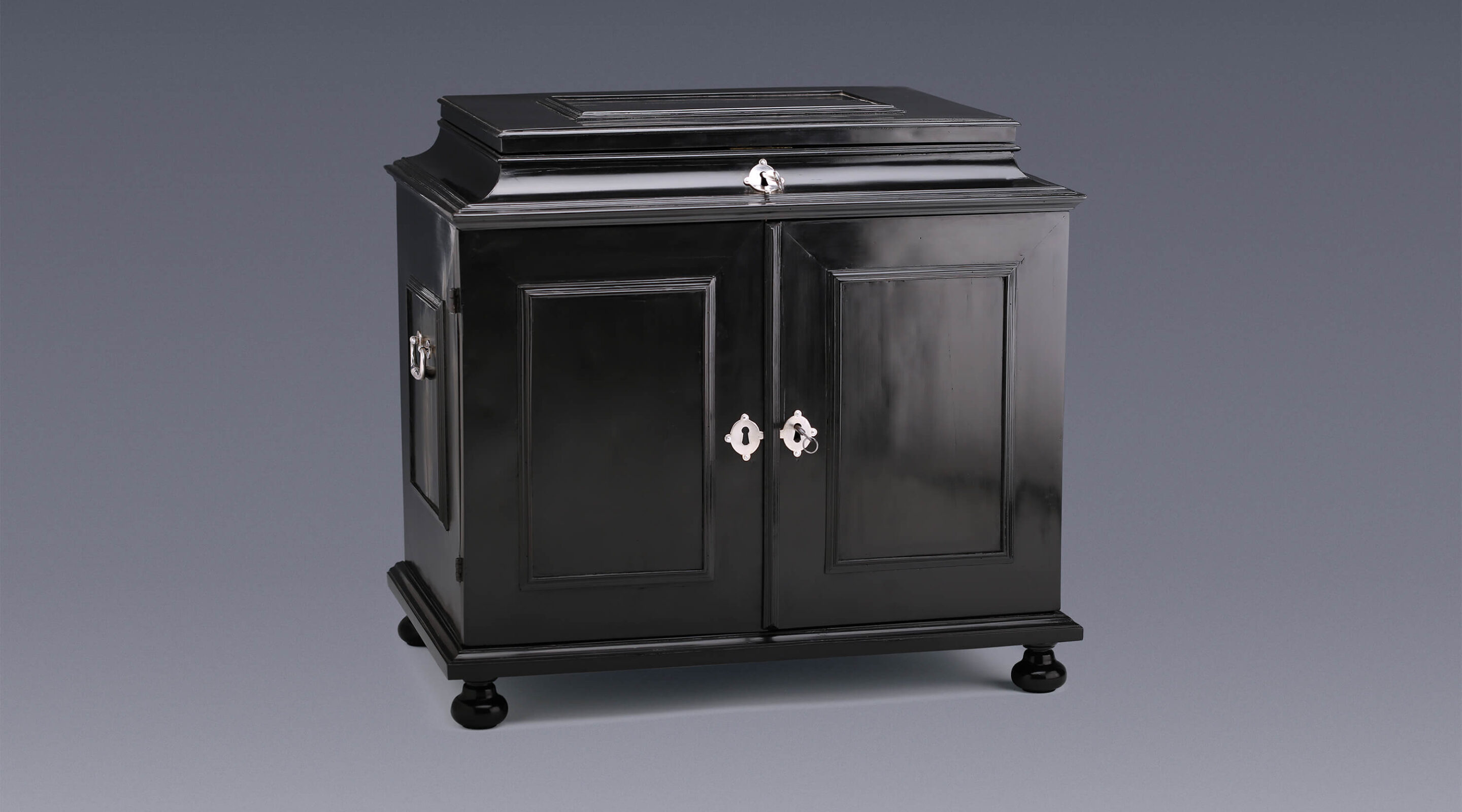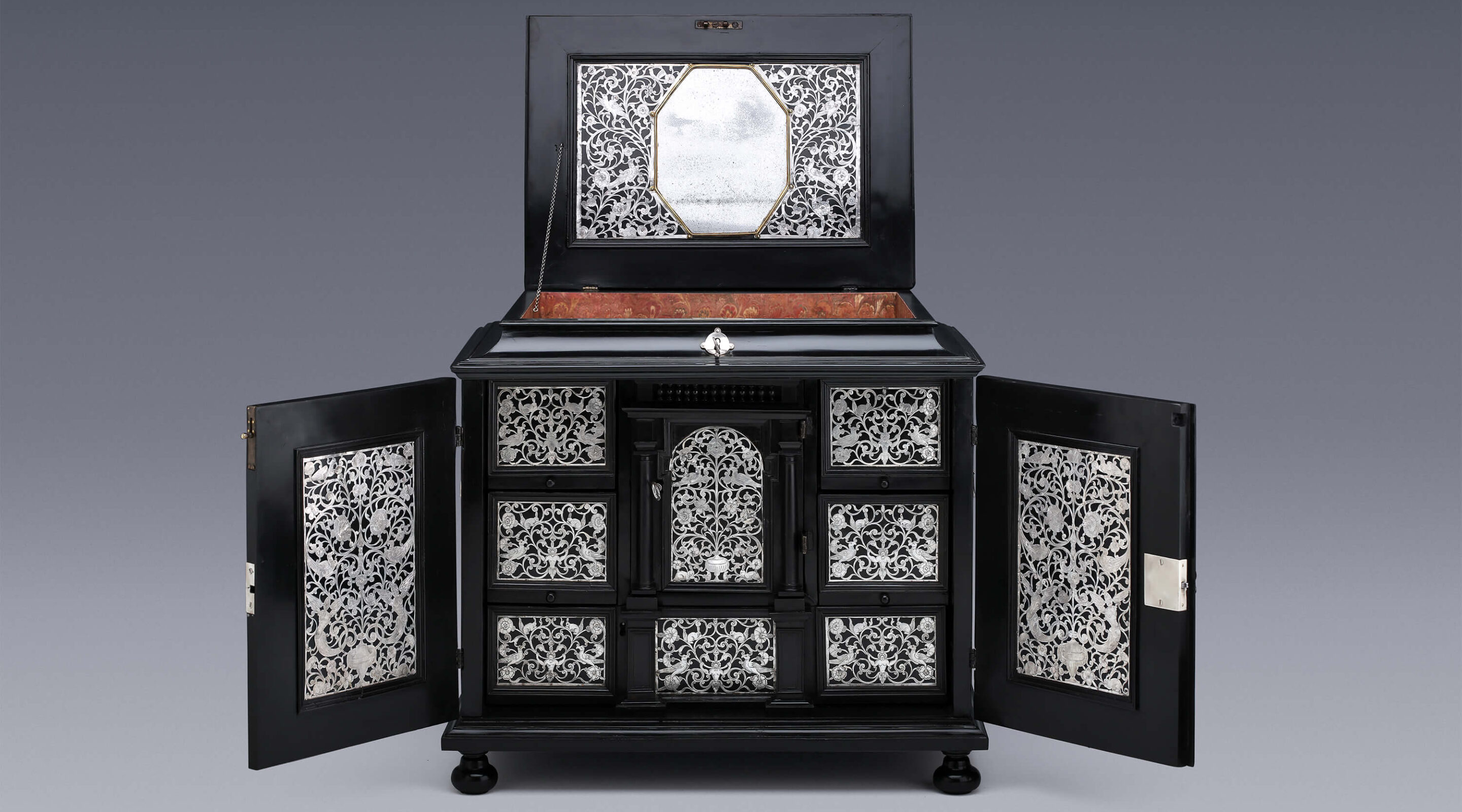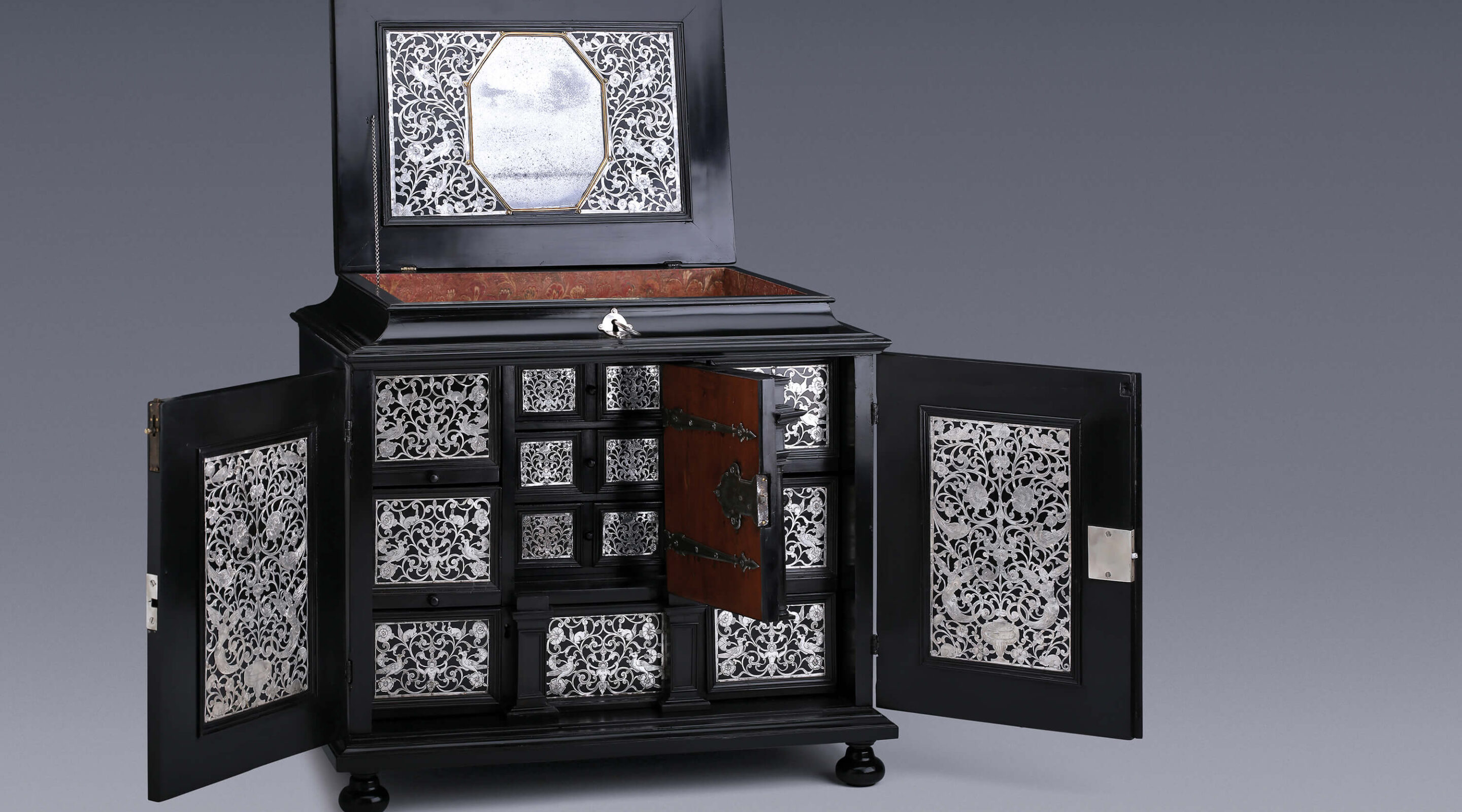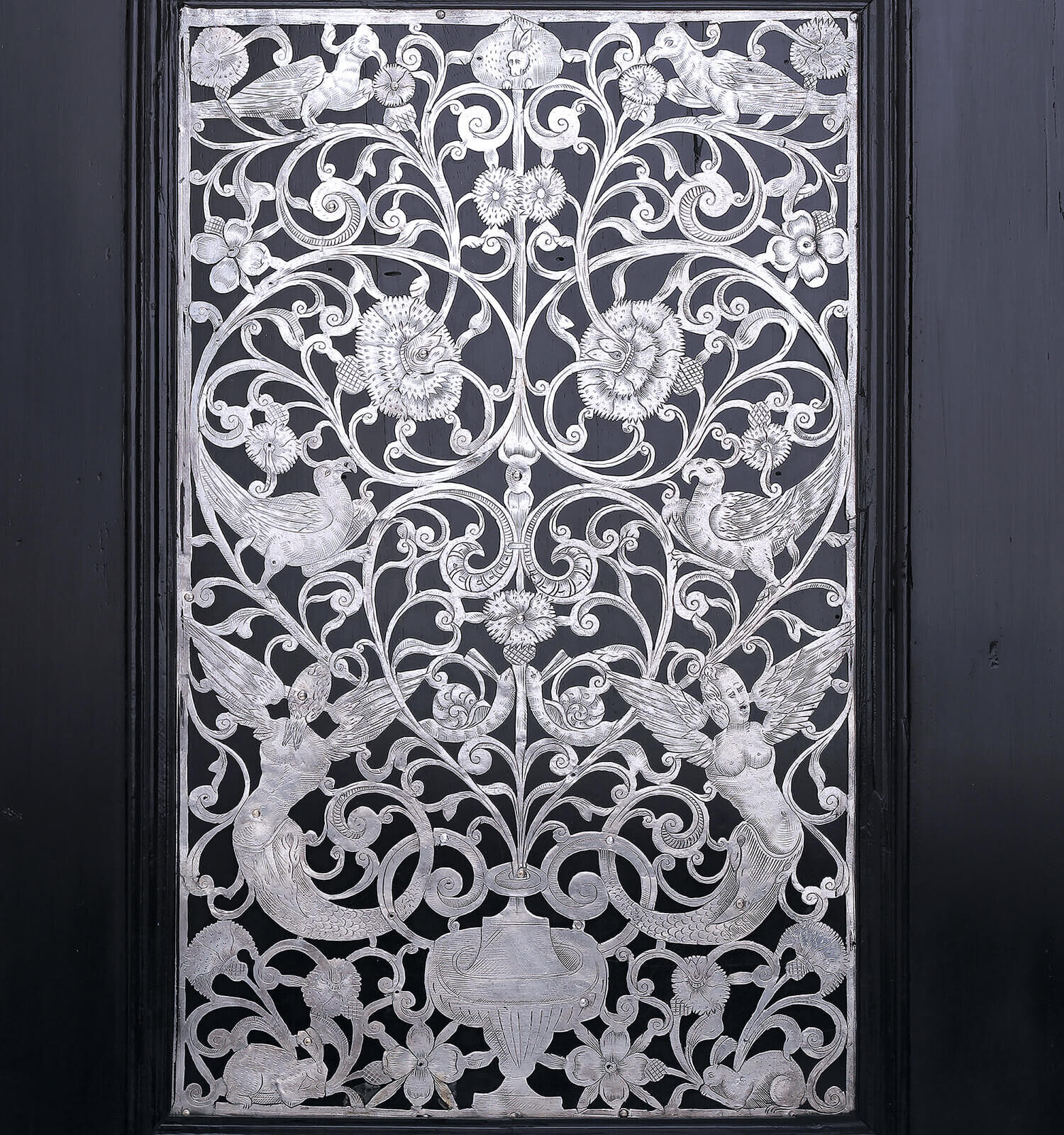At first glance, this ebony cabinet looks very restrained, but when the two doors and the lid are opened they reveal a magnificent interior decorated with silver panels. Cabinets of curiosities were a prominent feature of a collector’s art room in which the owner could show off his status and wealth, as well as his knowledge and power, and could display important conversation pieces.
Cabinet of Curiosities
Layout
This cabinet stands on four baluster feet and has a moulded plinth with two hinged doors above it with a moulded frame on the central section. The mountings on the outside of the cabinet are made of silver. Inside there is an architectural layout with in the centre a small hinged door with a lock and two ebony Doric columns, beneath a fronton with a balustrade of turned ebony balusters. On either side of the door there are two smaller drawers and a large lockable drawer across the full width on the underside. Behind the door there are three more smaller drawers one above the other. Each drawer has a small round ebony knob and is lined with marbled paper. On the top of the cabinet there is a hinged lid with a lock, which is held open by a silver chain and has an octagonal mirror in a moulded frame in the centre.
Eighteen Silver Panels
The interior of the costly ebony cabinet was decorated with silver. The fronts of all the drawers, the inside of the doors and the lid are fitted with eighteen finely cut out and engraved silver panels. There are two large rectangular silver panels on the insides of the doors, seven small rectangular silver panels on the drawers, an arched panel on the central inner door and six small silver panels on the three drawers behind it. Two large silver panels flank the mirror in the lid.
Identical ornamentation was also used on the rare and expensive Dutch silver book bindings
Silver Book Bindings
The design of the silver panels is entirely in line with the international fashion that was circulated throughout Europe in model books and sample prints. Draughtsmen, engravers and print artists like Nicolaas de Bruyn (active in Rotterdam after 1617), Michel Le Blon (in Amsterdam after 1610) and Hans Janssen (in Amsterdam after around 1622) moved from the Southern Netherlands and Germany to Holland, where the economy was flourishing. Their designs can clearly be seen in the silver on this cabinet. On all the silver panels there is a completely symmetrical decoration of vines, scrolls and flowers that was engraved and then cut out. Birds, rabbits, snails, squirrels, butterflies, sphinxes and vases were incorporated into the design. Identical ornamentation was also used on the front and back plates of the – equally rare and expensive – silver book bindings that were made in and around Amsterdam in about 1600. Only a few examples of these have survived and they are in the collections of the Metropolitan Museum in New York, the Ashmolean Museum in Oxford, Museum Boijmans van Beuningen in Rotterdam and Museum van Loon in Amsterdam. The designs drawings themselves can also be found in several museum collections, including this engraving by Hans Janssen in the Metropolitan Museum. The book bindings are always made of two silver panels. There are no fewer than eighteen such panels on this cabinet.
Function
The sixteenth century saw the appearance of small caskets fitted with two handles so that they were easy to move or transport. They had a flap at the front that served as a writing table. In the mid-sixteenth century this ‘cantoor’, also known as a ‘comptoir’ or ‘scribaen’ evolved into a cabinet. The flap at the front made way for two small doors. In the sixteenth century the French poet Gilles Corrozet described them as ‘caskets in which queens and duchesses store their jewellery, buttons, lace, gloves and writing materials’. In short, everything they needed for their elegant lifestyle.
The caskets could be closed and locked with a key, making it the ideal place to keep other valuables, such as bonds, medals, antique objects, precious stones, coins or silver boxes. The ‘cantoor’ was gradually developing into a cabinet.
Wealthy Cities
The earliest cabinets of curiosities came from the Southern German city of Augsburg, which developed into a renowned export centre for luxury furniture in the sixteenth century. Cabinets of curiosities were also made in other major cities in the second half of the sixteenth century, but the centre of the trade in them shifted to Antwerp on the outbreak of the thirty-years war in 1618.
No trouble or expense was spared
They were produced there on a large scale, as is evident from the many estate inventories which show that they were particularly popular in the Southern Netherlands in the seventeenth century. This was a sought-after export product that sold very well in wealthy cities like Paris and Amsterdam until well into the seventeenth century.
Ornately Executed
The earliest Southern Netherlandish cabinets were made of plain wood and sometimes clad with leather to make them watertight. Influenced by the fashion spreading from Germany and Italy, as the sixteenth century progressed, they became more and more ornately executed and decorated. By the seventeenth century the cabinet was a real showpiece. They were often intricately decorated with marquetry in different types and colours of wood and sometimes inlaid with tortoiseshell, ivory or mother of pearl, or fitted with silver panels. No trouble or expense was spared, and these exotic materials meant that the cabinets were costly and highly sought-after among wealthy merchants, aristocrats and diplomats.
Ebony
The most expensive wood used in cabinets of curiosities was ebony. This dense, black hardwood only grows in tropical regions and had to be imported mostly from Madagascar and the surrounding islands. From the sixteenth century onwards, it was shipped to Europe by the Portuguese, but after the establishment of the Dutch East India Company in 1602, Amsterdam became the major import centre.
The 'black gold' was a desirable material to use in cabinets of curiosities
The ebony used in furniture like this cabinet comes from the heartwood or innermost core of the tree. This is the only part that has this characteristic density and dark colour. Ebony trees must grow for more than a hundred years before they develop enough heartwood to be usable. Heartwood occurs when the innermost cells die and no longer admit any water or nutrients. Because materials no longer pass through this dense, ‘dead’ interior of the tree, deposits of materials such as tannins, oils, resins and salts remain in the heartwood. These different compounds cause the characteristic black colour of the ebony heartwood.
The hardness, almost black colour and lustrous surface made it so desirable that it was usually too expensive to use for anything but veneering.
Black Gold
Ebony objects were immediately recognizable in both East and West as valuable pieces. They were so costly that only royal houses, the aristocracy and the very rich could afford them. They were listed separately in inventories. Ebony was thus an ideal material to set oneself apart. From the beginning of the seventeenth century, the ‘black gold’ was a desirable material to use in Dutch cabinets of curiosities. It also frequently adorns the frames of Dutch paintings of the time.
As the French court in the Louvre had its menuisiers en ébène and the cabinet makers in France were called ébénistes, so in the early seventeenth century a new specialism – the ebony worker – emerged in Amsterdam. The best-known ebony worker in the Netherlands was Hendrik Doomer.
This site is protected by reCAPTCHA and the Google Privacy Policy and Terms of Service apply.



